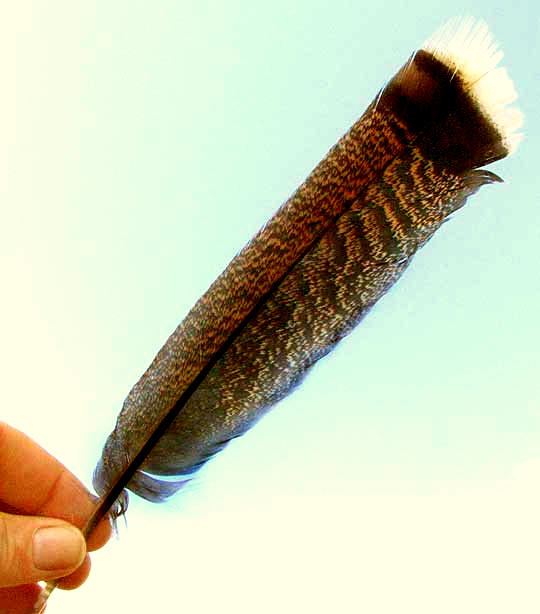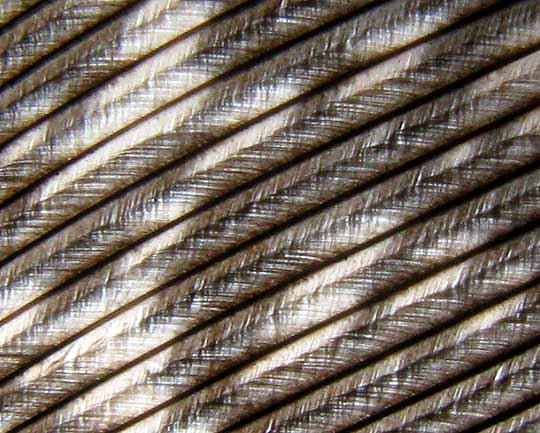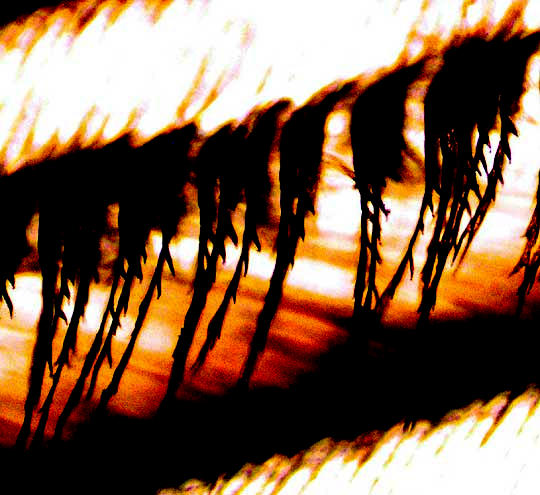In Wild Turkey country you often find what's shown below:

That's a feather from a Wild Turkey, and as with everything in life, once you start studying something -- something even as simple as a feather -- you find that there's a lot to know about it.
For example, feather tips can be pointed, rounded or squared. Our turkey feather is one of the minority of squared ones. Birds grow two kinds of feathers. The "contour" or "vaned" type covers the bird's body, then beneath the contour feathers lie down feathers. The feather in the picture is a contour type. Down feathers are smaller and fluffier.
The stiff, sharp "stem" by which the feather in the picture is held is the quill, or calamus. The stiff "midrib" running up the feather's center is variously called the rachis, shaft or stem. The main, flat, often pigmented part of the feather is known as the vane. The vanes of most feathers, like ours, have one side narrower than the other. The vane's narrow side is known as the outer vane and of course the wider side is the inner vane. The lowest and usually the widest part of the inner vane is often recognized as the up-curved edge.
Each semi-stiff little item arising from the rachis and meshing with its neighbor to form the flat vane is a barb. If you put our feather right up to your eye or use a low-power hand lens, and have a good light behind the feather, you can see what's shown below:

The dark lines running diagonally across the image are barbs. You can see that each barb is itself like a tiny feather, in that soft, feathery items arise from its sides. These feathery items are barbules. Notice that barbule tips on adjacent barbs overlap one another. Just by looking at how the barbules are arranged you can guess that the barbules of neighboring barbs somehow stick together, maybe in a Velcro-like manner.
It happens that a fine microscope with a camera adapter is available to me, so I've been able to take an even closer look at what's going on with these sticking-together barbs and barbules. Using the microscope's weakest magnification I looked at a barb in our turkey feather in which the barbules on one of its sides were attached to its neighbor's barbules, but the barbules on the other hung in the air because I'd pulled the barbs apart there. That image is shown below:

Notice that the downward-directed barbules of the silhouetted barb at the top, left partially overlap the horizontal barbules of the silhouetted barb at the bottom. Also, look at how the half of each barbule nearest the barb appears to be stiffer and more neatly organized parallel with its neighboring barbule than the barbule's outer end. Also, in the lower, right corner of the picture notice how the barbules' outer end bears tiny, spine-like items. You can see the spine-like items at a higher magnification below:

These spine-like items are hooks, so already you can guess that barbules from neighboring barbs stick together because hooks on the barbules latch onto the barbules of its neighboring barb. In the last picture, notice that many of the hooks really are hooked.
What a world a feather is!